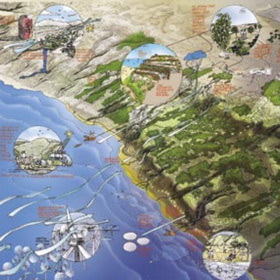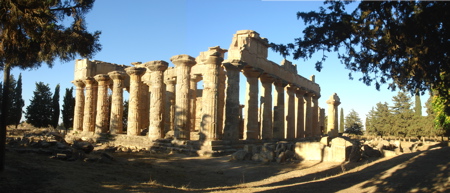
Cyrene Declaration by Foster + Partners
More from Foster: the architect has announced what is described as the world's "largest and most complete sustainable regional development".

Called the Cyrene Declaration, today's announcement launches a conservation and development programme for the Jabal al Akhdar (Green Mountain) region - a unspoiled 5,500sq km area on the Mediterranean coast of eastern Libya in North Africa.

Foster is involved in masterplanning the project, which will attempt to steer sustainable tourist development while preserving the largely pristine natural environment, which is dotted with archaeological sites.
Below is the press release; click here to download a PDF brochure about the project (2Mb file).
--
10 September 2007
World's largest and most complete sustainable regional development announced in Libya
At an historic ceremony amongst the archaeological treasures of Cyrene in the Green Mountain region of Eastern Libya, Saif al-Islam Gadafi, signed the Cyrene Declaration witnessed by an invited audience of journalists, VIP’s and people’s representatives from Libya and abroad.
The launch of the Cyrene Declaration marks the inception of the world’s first regional-scale conservation and development project dedicated to responding to the challenges and opportunities for sustainable development in The Green Mountain region covering some 5,500 sq kilometres. Foster + Partners are helping to develop the vision set out in the Cyrene Declaration.
This area is one of outstanding natural beauty and bio-diversity. It is described by the World Wildlife Fund as “…one of the 10 last paradises of the Mediterranean". Its coastal region has the potential to become one of the world’s most desirable tourist destinations. Its allure to visitors however depends on the effective protection of the natural environment and controlled development, free of urban sprawl.
The most urgent challenge is to tackle climate change by developing a new model of socio-economic development that minimises the release of greenhouse gases, diversifies sources of economic growth such as tourism and reduces its reliance on fossil fuels, moving towards C02 neutrality on a regional scale. With its emphasis on renewable energy and integrated regional planning Cyrene Declaration will also be of relevance to other countries.
The region is rich with prehistoric, Greek, Roman and Islamic antiquity. Of equal urgency is the protection of the local archaeological and natural treasures of The Green Mountain including one of the world’s most important UNESCO World Heritage Sites at Cyrene. This is central to the regional plan, creating commercial opportunities leading to thousands of new jobs for local communities.
The vision not only addresses the environmental impact of development but also concerns the people involved. The final challenge is to improve the economic and social fortunes of the inhabitants of The Green Mountain who are disproportionately young and lacking in employment. The creation of sustainable, compact, mixed use settlements as well as the modernisation of schools and public amenities and intelligent infrastructure, all play a vital role in enabling a vibrant economy for the indigenous population.
The Green Mountain Conservation and Development Authority (GMCDA) has been established to oversee the creation, development and management of a National Park, archaeological conservation areas, mixed use areas for commerce and cultural and environmental tourism, sustainable infrastructure, renewable power generation and a range of facilities for the local population.
Foster + Partners have been appointed to develop three sustainable pilot projects to facilitate cultural and eco-tourism and these are already under way in The Green Mountain and the Guiding Principles of the Cyrene Declaration are also being applied to other development projects elsewhere in Libya
Lord Foster said: “This is one of the most beautiful and little know landscapes on Earth. We’ve been give a unique challenge: to establish a sustainable blueprint for future development which will be sensitive to the history of the Green Mountain and to its conservation"